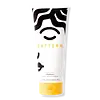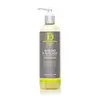What's inside
What's inside
 Key Ingredients
Key Ingredients

 Benefits
Benefits

 Concerns
Concerns

 Ingredients Side-by-side
Ingredients Side-by-side

Water
Skin ConditioningSodium C14-16 Olefin Sulfonate
CleansingCocamidopropyl Betaine
CleansingPropanediol
SolventGlycol Distearate
EmollientArgania Spinosa Kernel Oil
EmollientCocos Nucifera Oil
MaskingMel
EmollientMelaleuca Alternifolia Leaf Oil
AntioxidantOlea Europaea Fruit Oil
MaskingBiotin
AntiseborrhoeicPersea Gratissima Oil
Skin ConditioningRicinus Communis Seed Oil
MaskingSimmondsia Chinensis Seed Oil
EmollientButyrospermum Parkii Butter
Skin ConditioningAloe Barbadensis Leaf Juice
Skin ConditioningPrunus Amygdalus Dulcis Oil
Skin ConditioningGlycine Soja Oil
EmollientGlycine Soja Sterols
EmollientGlycolipids
Skin ConditioningGlycerin
HumectantPhospholipids
Skin ConditioningAmodimethicone
Guar Hydroxypropyltrimonium Chloride
Skin ConditioningHydroxyethylcellulose
Emulsion StabilisingLauryl Lactyl Lactate
Skin ConditioningHydroxyacetophenone
AntioxidantPEG-150 Distearate
EmulsifyingParfum
MaskingHydrolyzed Vegetable Protein Pg-Propyl Silanetriol
Skin ConditioningCellulose
AbsorbentPhenoxyethanol
PreservativeCitric Acid
BufferingPEG-150 Stearate
Disodium EDTA
PEG-1m
Emulsion StabilisingStearic Acid
CleansingSodium Hydroxide
BufferingSodium Acetate
BufferingPotassium Sorbate
PreservativeSodium Benzoate
MaskingLinalool
PerfumingWater, Sodium C14-16 Olefin Sulfonate, Cocamidopropyl Betaine, Propanediol, Glycol Distearate, Argania Spinosa Kernel Oil, Cocos Nucifera Oil, Mel, Melaleuca Alternifolia Leaf Oil, Olea Europaea Fruit Oil, Biotin, Persea Gratissima Oil, Ricinus Communis Seed Oil, Simmondsia Chinensis Seed Oil, Butyrospermum Parkii Butter, Aloe Barbadensis Leaf Juice, Prunus Amygdalus Dulcis Oil, Glycine Soja Oil, Glycine Soja Sterols, Glycolipids, Glycerin, Phospholipids, Amodimethicone, Guar Hydroxypropyltrimonium Chloride, Hydroxyethylcellulose, Lauryl Lactyl Lactate, Hydroxyacetophenone, PEG-150 Distearate, Parfum, Hydrolyzed Vegetable Protein Pg-Propyl Silanetriol, Cellulose, Phenoxyethanol, Citric Acid, PEG-150 Stearate, Disodium EDTA, PEG-1m, Stearic Acid, Sodium Hydroxide, Sodium Acetate, Potassium Sorbate, Sodium Benzoate, Linalool
Water
Skin ConditioningSodium C14-16 Olefin Sulfonate
CleansingCocamidopropyl Hydroxysultaine
CleansingPolyquaternium-7
Cocamide Mea
EmulsifyingAcrylamidopropyltrimonium Chloride/Acrylamide Copolymer
Phenoxyethanol
PreservativeBenzoic Acid
MaskingEthylhexylglycerin
Skin ConditioningGlycereth-2 Cocoate
EmulsifyingPropanediol
SolventGlycol Distearate
EmollientPrunus Amygdalus Dulcis Fruit Water
Skin ConditioningPersea Gratissima Fruit Extract
EmollientButyrospermum Parkii Leaf Extract
EmollientOlea Europaea Fruit Extract
BleachingSimmondsia Chinensis Seed Extract
AbrasiveTheobroma Cacao Extract
Skin ConditioningCocos Nucifera Fruit Extract
EmollientAleurites Moluccanus Seed Extract
Skin ConditioningParfum
MaskingBenzyl Benzoate
AntimicrobialCitral
PerfumingGeraniol
PerfumingLinalool
PerfumingLimonene
PerfumingWater, Sodium C14-16 Olefin Sulfonate, Cocamidopropyl Hydroxysultaine, Polyquaternium-7, Cocamide Mea, Acrylamidopropyltrimonium Chloride/Acrylamide Copolymer, Phenoxyethanol, Benzoic Acid, Ethylhexylglycerin, Glycereth-2 Cocoate, Propanediol, Glycol Distearate, Prunus Amygdalus Dulcis Fruit Water, Persea Gratissima Fruit Extract, Butyrospermum Parkii Leaf Extract, Olea Europaea Fruit Extract, Simmondsia Chinensis Seed Extract, Theobroma Cacao Extract, Cocos Nucifera Fruit Extract, Aleurites Moluccanus Seed Extract, Parfum, Benzyl Benzoate, Citral, Geraniol, Linalool, Limonene
Ingredients Explained
These ingredients are found in both products.
Ingredients higher up in an ingredient list are typically present in a larger amount.
Glycol Distearate serves as a pearlizing or opacifying agent in cosmetic products.
It's often included in cleansers and haircare products to give them a lustrous or shimmering appearance.
It is derived from stearic acid, a natural fatty acid commonly found in vegetable oils and animal fats.
Glycol Distearate isn't fungal acne safe.
Learn more about Glycol DistearateLinalool is a fragrance and helps add scent to products. It's derived from common plants such as cinnamon, mint, citrus, and lavender.
Like Limonene, this ingredient oxidizes when exposed to air. Oxidized linalool can cause allergies and skin sensitivity.
This ingredient has a scent that is floral, spicy tropical, and citrus-like.
Learn more about LinaloolParfum is a catch-all term for an ingredient or more that is used to give a scent to products.
Also called "fragrance", this ingredient can be a blend of hundreds of chemicals or plant oils. This means every product with "fragrance" or "parfum" in the ingredients list is a different mixture.
For instance, Habanolide is a proprietary trade name for a specific aroma chemical. When used as a fragrance ingredient in cosmetics, most aroma chemicals fall under the broad labeling category of “FRAGRANCE” or “PARFUM” according to EU and US regulations.
The term 'parfum' or 'fragrance' is not regulated in many countries. In many cases, it is up to the brand to define this term.
For instance, many brands choose to label themselves as "fragrance-free" because they are not using synthetic fragrances. However, their products may still contain ingredients such as essential oils that are considered a fragrance by INCI standards.
One example is Calendula flower extract. Calendula is an essential oil that still imparts a scent or 'fragrance'.
Depending on the blend, the ingredients in the mixture can cause allergies and sensitivities on the skin. Some ingredients that are known EU allergens include linalool and citronellol.
Parfum can also be used to mask or cover an unpleasant scent.
The bottom line is: not all fragrances/parfum/ingredients are created equally. If you are worried about fragrances, we recommend taking a closer look at an ingredient. And of course, we always recommend speaking with a professional.
Learn more about ParfumPhenoxyethanol is a preservative that has germicide, antimicrobial, and aromatic properties. Studies show that phenoxyethanol can prevent microbial growth. By itself, it has a scent that is similar to that of a rose.
It's often used in formulations along with Caprylyl Glycol to preserve the shelf life of products.
Propanediol is an all-star ingredient. It softens, hydrates, and smooths the skin.
It’s often used to:
Propanediol is not likely to cause sensitivity and considered safe to use. It is derived from corn or petroleum with a clear color and no scent.
Learn more about PropanediolSodium C14-16 Olefin Sulfonate is a cleansing agent made from a mixture of long chain sulfonate salts. It can also help produce foam.
This ingredient may be drying. We recommend speaking with a professional if you have concerns.
Water. It's the most common cosmetic ingredient of all. You'll usually see it at the top of ingredient lists, meaning that it makes up the largest part of the product.
So why is it so popular? Water most often acts as a solvent - this means that it helps dissolve other ingredients into the formulation.
You'll also recognize water as that liquid we all need to stay alive. If you see this, drink a glass of water. Stay hydrated!
Learn more about Water